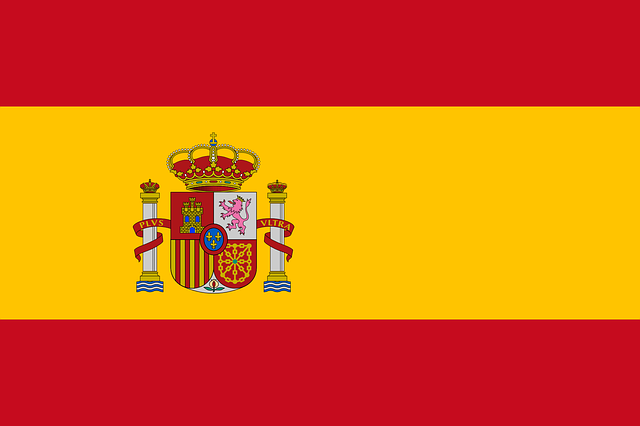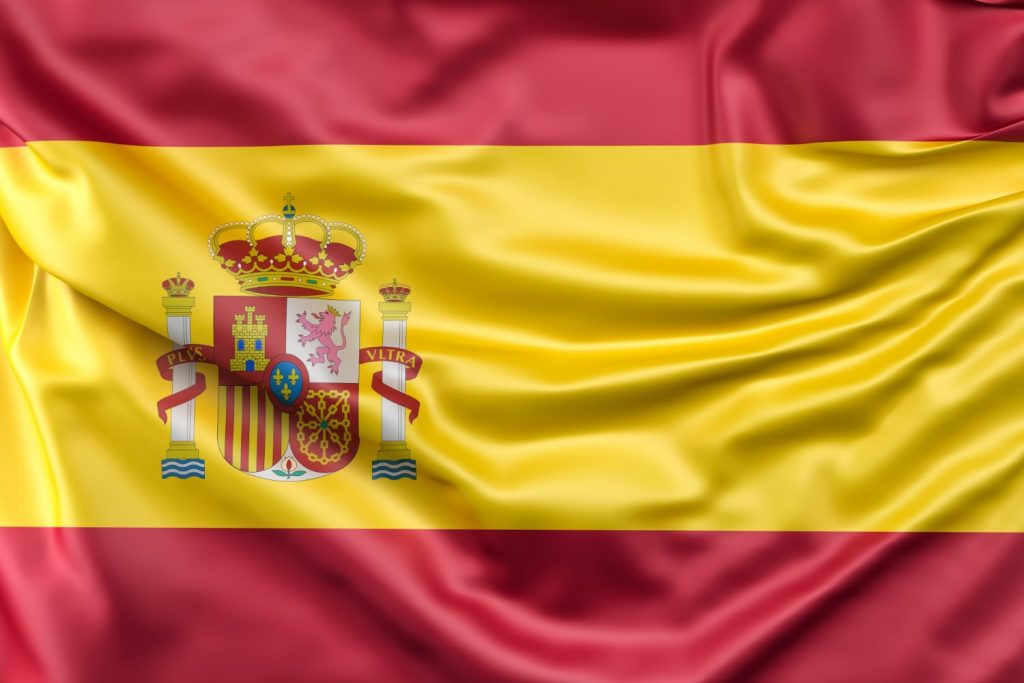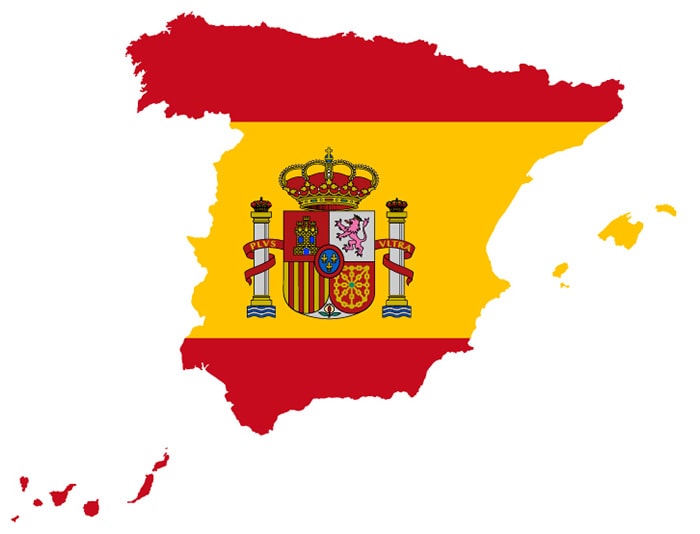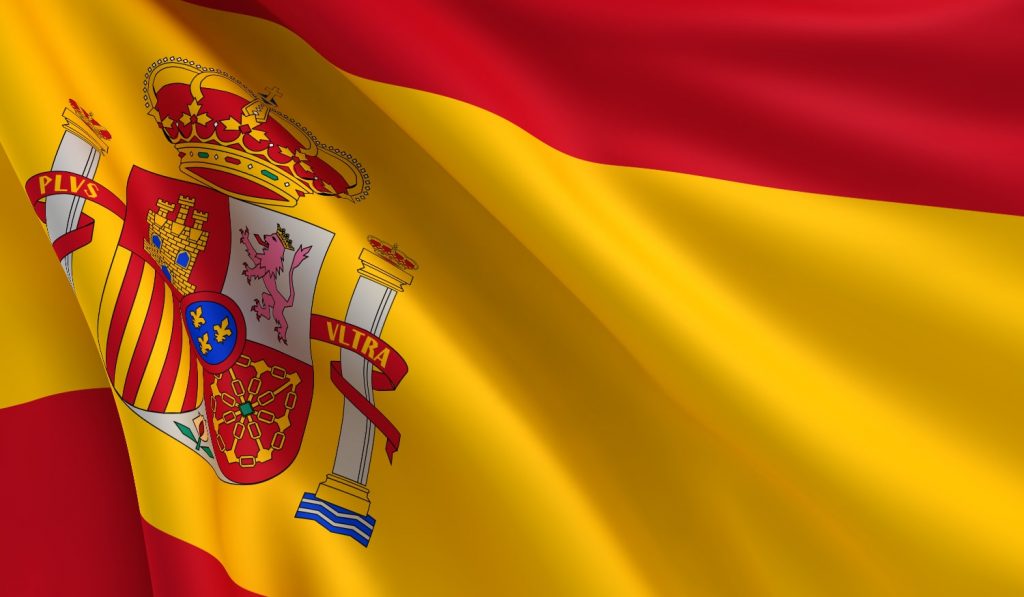Flag of Spain

Spanish flag
- Official approval of the flag: 1981
- Flag emoji: 🇪🇸
- Period: Modern flags
- Type of flag: Flags of countries • Flags of continental countries
- Belonging to the continent: Europe
- Colors on the flag: yellow • red
- Emblem on the flag: National coat of arms
Spain is located in the southwest of Europe, on the Iberian Peninsula, bordering Portugal, France and Andorra. The capital is Madrid. The country’s area is 505,992 km², and the population is about 47 million people. The official language is Spanish, but Catalan, Basque, and Galician are also spoken in the regions. Spain is known for its resorts, architectural heritage, and culture. The national composition includes Spaniards, Catalans, Basques, and Galicians.
The Spanish flag, known as the “Rojigualda” because of the combination of red (rojo) and gold (gualda), is the official symbol of the Kingdom of Spain. It consists of three horizontal stripes: two red stripes at the top and bottom, and a wide golden stripe in the middle. In its modern form, the flag combines the country’s long history, monarchical heritage, and democratic values.

History of the Spanish flag
The modern design of the Spanish flag was approved in the 18th century, but the colors and shape of the symbol have changed over the centuries depending on political regimes and state structures.
The origin of the flag
- Until the 18th century, Spain used different versions of flags, which often included white cloths with symbols of royal dynasties.
- In 1785, King Charles III approved a red and gold flag for the navy. Its design was chosen from among 12 designs to create a flag that was easily distinguishable from other national flags at sea.
- The colors red and gold have deep roots in Spanish heraldry. They are associated with the historical kingdoms of Castile (red) and Aragon (gold).
Development and modernity
- In 1843, the flag was officially approved as the national symbol of Spain.
- During the Second Republic (1931-1939), the design of the flag was changed: purple was used instead of red.
- In 1939, after the Civil War, the traditional red and gold flag was returned.
- The modern version of the flag with the coat of arms of the Kingdom of Spain was officially approved by the Constitution of 1978 after the establishment of democracy.

Colors of the Spanish flag
Meaning of the colors
The colors of the Spanish flag reflect the country’s rich historical and cultural heritage:
- Red:
- Symbolizes courage, blood shed for independence, and strength.
- Reflects the heraldic color of Castile.
- Gold:
- It represents wealth, generosity and sunshine.
- It is associated with the Kingdom of Aragon and the country’s natural resources.
Color codes

Standardized colors in different systems have been approved to ensure accurate display of the flag.
- Red:
- RGB: (198, 47, 52)
- HEX: #C62F34
- CMYK: (0, 76, 80, 22)
- Pantone: 186 C
- Gold:
- RGB: (253, 209, 22)
- HEX: #FDD116
- CMYK: (0, 18, 91, 1)
- Pantone: 7406 C
Coat of arms on the flag
On the golden stripe of the modern flag is the national emblem of Spain. It includes symbols of historical kingdoms:
- Castile: a castle.
- Leon: a lion.
- Aragon: stripes.
- Navarre: chains.
- Granada: a pomegranate.
In the center of the coat of arms is a blue shield with white lilies, which symbolizes the Bourbon dynasty, to which the current King of Spain belongs. On either side are the columns of Hercules, topped by a ribbon with the inscription “Plus Ultra”, which means “Further than the Borders” – a symbolic reminder of Spanish discoveries outside Europe.

Format and proportions
The Spanish flag has a standardized design to ensure that it can be used accurately in official and unofficial contexts.
Flag proportions
The proportions of the flag are 2:3. The height of the flag is two-thirds of its width.
The arrangement of the stripes
The flag consists of three horizontal stripes:
- The upper red stripe occupies 1/4 of the height.
- The central golden stripe occupies 1/2 of the height.
- The lower red stripe occupies 1/4 of the height.
Location of the coat of arms
The coat of arms is located on the left side of the flag on a golden stripe. It occupies approximately two-thirds of the height of the golden stripe.

Interesting facts about the flag of Spain
- Spain was one of the first countries to use colored flags for identification at sea.
- Red and gold colors are often associated with bullfighting and fiestas, which emphasizes the unique Spanish culture.
- The Spanish flag is one of the few flags in the world that includes the official coat of arms in its design.
The Spanish flag is an important symbol of national pride and history. Its red and gold colors reflect the country’s heritage, the richness of its culture, and the struggle for unity. As a unique element of identity, it represents Spain on the international stage and remains a source of inspiration for its people.
